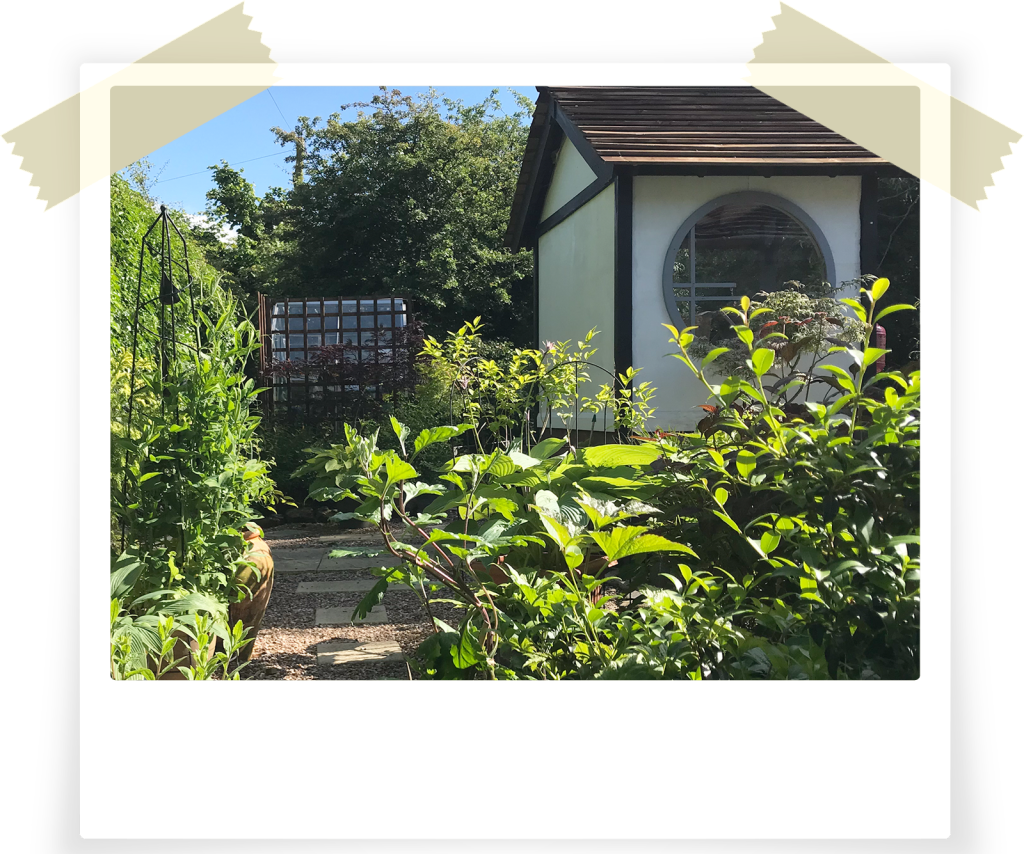I know well that the June rains just fall.” Onitsura
As the Haiku poet has written, Japan’s rainy season begins in June but is not supposed to, here in Derbyshire. Nevertheless wet Spring days, short and sharp or persistent, have featured since mid-May. But it’s the unseasonably cool temperatures so far, barely topping 13-15C in the daytime, that is causing the most grief to gardener and plants. Slugs and snails are in freefall and the blue Alder leaf beetle has been turning up on my two miniature apple and pear trees, both still barren. There’s also an abundance of the’ cuckoo spit’ bug, the larvae of the sap sucking froghopper. In turn viruses make the most of weakened plants and hence mildews are effecting those which by now expect warmer, brighter weather, including honeysuckles and roses.

Of course there are plants that thrive in these current conditions and being a Japanese style garden there are plenty of archetypical hydrangeas and hostas, now full of leaf and bud (the latter are potted on the gravel levels and so predation by gastropods is kept to a minimum).
In the vegetable beds, most seeds sown directly have not germinated. This may be due to the cooler temperatures rather than the clay soil but either way I’ve decided in future to do most sowing in containers first.
Runner and French beans are slowly making their way up the poles, with a second sowing in the greenhouse, awaiting their turn. Attempting to put on leaves faster than pests can consume them are Chinese cabbage as well as a selection of peas, so extra protection around them is necessary. The high yield ‘Jolant’ leeks are growing straight and strong whilst Maris Peer spuds are looking healthy, in their duck straw beds. If the wet does not rot them, there should be sufficient tubers for summer lunches to combine with the edible flowers and Cos lettuce currently growing well in containers.
Two winters ago I took a few hardwood cuttings of an unnamed Deutzia (see Next Year’s Line-Up). This genus of shrubs are mostly Japanese or Chinese in origin and hence ideal for my garden style. Further research suggests that the plants are probably D. x hybrida ‘Mont Rose’ but there are enough subspecies and varieties of pink Deutzias to cause confusion. Time will tell, I hope.

Although still small in stature, the Deutzias’ starry rose-pink blooms are dense and abundant and they now reside in the part sun, Japanese woodland bed behind Acer Sei-ryu. The intention being to clip the shrubs eventually as a small border hedge.
At the top of one of the sloping cascade beds a tall, mystery cranesbill has suddenly emerged. Growing in the centre of a hemerocallis/daylily purchased from a plant stall last summer, this is a most adventitious 2 for 1 purchase.

The outward-facing lavender-lilac blooms have pale, ‘pencilled’ definitions, which glow when backlit by the late afternoon light. This description would seem to fit the Geranium pratense ‘Mrs Kendall Clark’ (the origins of which are very well detailed by Dorset perennials.)
So despite the cold June weather so far there is still more than enough in the garden to give me a warm reception, daily.
We will hopefully get some warmer weather eventually I hope, but by then most of the blooms will have faded or been eaten I fear. The geranium definitely looks like ‘Mrs Kendall Clark’ – a beautiful soft lilac-grey flower. Mine is in full spate at the moment, but she doesn’t last long. I found that my daylily is a great hiding place for snails which have feasted not only on the leaves, but also the flowers. Decision time. Whether to compost it or try using a container. One way or another it has to go from the bed it is in.
I keep hoping Jude but the weather runes are not promising – thank you for the geranium confirmation. A real beauty perhaps more so if ephemeral. I’ve just put daylily from pot to ground and so far the gastropods have not nested there but prefer to congregate under the Ajugas!
Oh the weather… same here in Southern Germany, Laura. It either pours and attracts the gastropods, but keeps us from clearing the veg bed from weeds and proceed with putting out the seedlings, or – as is the case this week – 30C temps.
We’ve bought but a couple of bell peppers as small plants, the rest we sowed everything in containers first. We, too, have clay soil, and combine this with gastropods… the giant dahlia was already reduced to nothing but now have peppered its surroundings with tiny crushed egg shells in the hope it will keep the critters away.
Wishing you better weather and much success with what is yet to grow!